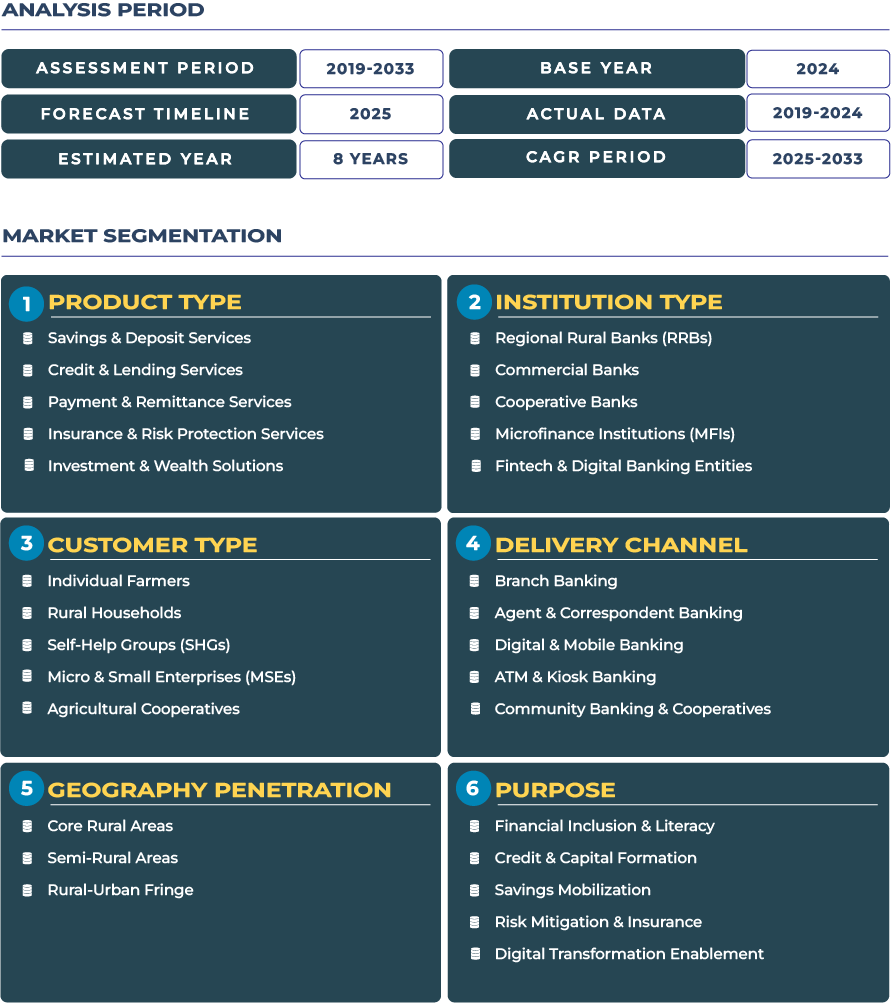Bridging Inclusion and Export Competitiveness: The Expanding Landscape of South Africa Rural Banking Market
South Africa rural banking market is evolving from a historically underpenetrated financial sector into a cornerstone of agricultural modernization and export competitiveness. As the country pushes forward with land reform and export-oriented agri-policy, rural banking institutions have become vital in linking smallholder farmers, cooperatives, and agribusinesses to structured financial ecosystems. The sector, valued at USD 15.1 billion in 2025 and projected to reach USD 19.7 billion by 2033 at a CAGR of 3.4%, is demonstrating how financial inclusion and export chain efficiency can jointly fuel sustainable economic growth. This evolution aligns closely with South Africa’s national development priorities under the National Development Plan 2030, which emphasizes inclusive rural prosperity and improved access to finance. The rise of blended land-financing models, digital rural savings products, and export-focused loan instruments reflects a market transforming from basic deposit-taking to sophisticated, multi-layered value-chain finance.
Note:* The market size refers to the total fees/revenue generated by banks through various services.
South Africa Rural Banking Market Outlook: Blended Land Finance and Export-Chain Credit as Catalysts of Inclusive Growth
Rural banking in South Africa is increasingly seen as the financial backbone of agricultural transformation, particularly under the government’s emphasis on land redistribution and agrarian commercialization. The sector’s steady expansion is underpinned by the dual goals of empowering previously marginalized rural landowners and enhancing South Africa’s competitiveness in global food exports. Banks are introducing hybrid products that blend traditional savings and credit services with specialized export-chain financing, particularly for high-value sectors such as citrus, macadamia, and wine. The South African Reserve Bank and the Department of Agriculture, Land Reform and Rural Development have both reinforced the importance of rural credit channels that integrate with national value-chain finance frameworks. Moreover, initiatives around cold-chain export finance, providing loans for refrigerated logistics, agri-processing, and quality certification, are bridging the gap between smallholder productivity and global competitiveness. Despite challenges such as infrastructure gaps and climate volatility, the rural banking industry is strategically positioned to support export-oriented and inclusive agricultural growth.
Drivers & Restraints: Structural Transformation Amid Uneven Terrain
Empowered Cooperatives and Hybrid Farm Structures Propel Market Momentum
The growth of South Africa rural banking sector is fueled by its diverse agricultural base and the rise of formalized agri-cooperatives in provinces such as Western Cape, KwaZulu-Natal, and Limpopo. These cooperatives, now recognized as viable financial clients, are increasingly utilizing credit and lending services for machinery leasing, irrigation systems, and crop insurance. Banks such as Absa Bank and Standard Bank have expanded their rural branches and digital platforms to accommodate credit scoring for semi-formal enterprises. The growing demand for risk protection products, micro-savings accounts, and mobile-based payment systems has further diversified revenue streams across rural South Africa. This structural shift is supported by policy measures that incentivize inclusive finance, allowing smallholders to access blended loans for farm consolidation and export certification.
Persistent Inequality and Infrastructure Gaps Constrain Growth Potential
Despite progress, regional inequality and limited infrastructure remain major impediments to rural financial inclusion. Former homeland regions, such as parts of Eastern Cape and Mpumalanga, continue to suffer from limited broadband connectivity, low asset formalization, and weak credit enforcement frameworks. Rural crime and land disputes also elevate risk premiums, discouraging banks from deeper penetration in remote zones. Furthermore, inconsistent water access, energy supply interruptions, and logistics bottlenecks elevate the cost of agricultural credit. These structural hurdles not only slow down credit flow but also limit the scalability of investment and wealth solutions in rural districts. Addressing these challenges demands a coordinated approach between government-led development banks and commercial lenders, reinforced by regulatory innovation from the South African Reserve Bank to de-risk rural lending portfolios.
Trends & Opportunities: Converging Innovation and Inclusion in South Africa Rural Banking Ecosystem
Agri-SME Financing Anchored by Offtake Contracts Redefines Lending Security
One of the defining trends in South Africa rural banking sector is the surge in agri-SME financing backed by formal offtake contracts. These agreements, common in sugar, grain, and citrus value chains, provide banks with revenue visibility, enabling more favorable loan terms for smallholders. The integration of digital credit scoring and mobile wallet repayment systems is transforming how banks engage with dispersed farming communities. Regional fintech collaborations, often supported by provincial agri-development agencies, are bridging credit access gaps, allowing farmers to build a verifiable transaction history that supports long-term wealth creation. This approach is reshaping credit behavior in rural South Africa, fostering both financial literacy and disciplined borrowing.
Transitional Land-Finance and Cold-Chain Loans Open Pathways for Export Competitiveness
The emergence of transitional land-finance products with blended guarantees is creating new opportunities in rural credit. Such products, often co-designed by banks and state-backed funds, lower political and default risks associated with post-reform land ownership. In May 2025, a national land-finance initiative launched transitional loans that provided blended credit guarantees for smallholder commercialization in former homeland regions. Similarly, in September 2025, a major regional bank announced a partnership with a cold-chain logistics provider to finance export infrastructure for fruit growers. These innovations align with South Africa’s export diversification strategy and the broader rural economic revitalization agenda, positioning rural banking institutions as catalysts for cross-sector transformation.
Competitive Landscape: Strategic Collaborations and Policy-Backed Financing Drive Evolution
South Africa rural banking landscape is marked by the growing interplay between traditional financial institutions, development finance bodies, and private sector enablers. Banks such as Nedbank, Absa, and Standard Bank, along with state-linked institutions like the Industrial Development Corporation (IDC) and the Land and Agricultural Development Bank of South Africa, have expanded their portfolios to include specialized rural finance and export-chain solutions. Recent developments such as transitional loan programs and cold-chain financing for exporters underscore how South African banks are aligning profitability with developmental mandates. The ecosystem is further reinforced by financial literacy drives, mobile banking innovations, and partnerships with agritech startups. Together, these initiatives represent a shift toward an integrated, digitally enabled, and policy-aligned rural financial architecture that can sustain both inclusion and export competitiveness.







